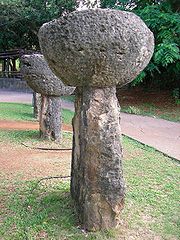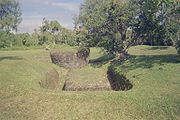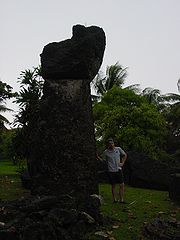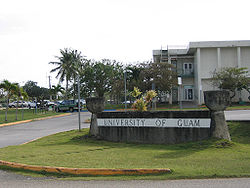
Latte Stones
Encyclopedia

Column
A column or pillar in architecture and structural engineering is a vertical structural element that transmits, through compression, the weight of the structure above to other structural elements below. For the purpose of wind or earthquake engineering, columns may be designed to resist lateral forces...
(Chamorro language
Chamorro language
Chamorro is a Malayo-Polynesian language, spoken on the Mariana Islands by about 47,000 people Chamorro (Chamorro: Fino' Chamoru or simply Chamoru) is a Malayo-Polynesian (Austronesian) language, spoken on the Mariana Islands (Guam, Rota, Tinian, and Saipan) by about 47,000 people Chamorro...
: haligi) capped by a hemispherical
Sphere
A sphere is a perfectly round geometrical object in three-dimensional space, such as the shape of a round ball. Like a circle in two dimensions, a perfect sphere is completely symmetrical around its center, with all points on the surface lying the same distance r from the center point...
stone capital
Capital (architecture)
In architecture the capital forms the topmost member of a column . It mediates between the column and the load thrusting down upon it, broadening the area of the column's supporting surface...
(tasa) with the flat side facing up. Used as building supports by the ancient Chamorro people, they are found throughout most of the Mariana Islands
Mariana Islands
The Mariana Islands are an arc-shaped archipelago made up by the summits of 15 volcanic mountains in the north-western Pacific Ocean between the 12th and 21st parallels north and along the 145th meridian east...
. In modern times, the latte stone is seen as a sign of Chamorro identity and is used in many different contexts.
Construction

Limestone
Limestone is a sedimentary rock composed largely of the minerals calcite and aragonite, which are different crystal forms of calcium carbonate . Many limestones are composed from skeletal fragments of marine organisms such as coral or foraminifera....
, basalt
Basalt
Basalt is a common extrusive volcanic rock. It is usually grey to black and fine-grained due to rapid cooling of lava at the surface of a planet. It may be porphyritic containing larger crystals in a fine matrix, or vesicular, or frothy scoria. Unweathered basalt is black or grey...
, or sandstone
Sandstone
Sandstone is a sedimentary rock composed mainly of sand-sized minerals or rock grains.Most sandstone is composed of quartz and/or feldspar because these are the most common minerals in the Earth's crust. Like sand, sandstone may be any colour, but the most common colours are tan, brown, yellow,...
. Typical pillars range in height from 60 centimeters to three meters, and generally narrow towards the top. The pillar was normally quarried and then transported to the construction site. For small to medium sized lattes, the capstone was a large hemispherical coral
Coral
Corals are marine animals in class Anthozoa of phylum Cnidaria typically living in compact colonies of many identical individual "polyps". The group includes the important reef builders that inhabit tropical oceans and secrete calcium carbonate to form a hard skeleton.A coral "head" is a colony of...
head that was gathered from a reef
Reef
In nautical terminology, a reef is a rock, sandbar, or other feature lying beneath the surface of the water ....
. The massive capstones found in Rota
Rota (island)
Rota also known as the "peaceful island", is the southernmost island of the United States Commonwealth of the Northern Mariana Islands and the second southernmost of the Marianas Archipelago. It lies approximately 40 miles north-northeast of the United States territory of Guam...
were instead quarried, like the pillars.
In Oceania
Oceania
Oceania is a region centered on the islands of the tropical Pacific Ocean. Conceptions of what constitutes Oceania range from the coral atolls and volcanic islands of the South Pacific to the entire insular region between Asia and the Americas, including Australasia and the Malay Archipelago...
the latte stone is unique to the Marianas, though megalith
Megalith
A megalith is a large stone that has been used to construct a structure or monument, either alone or together with other stones. Megalithic describes structures made of such large stones, utilizing an interlocking system without the use of mortar or cement.The word 'megalith' comes from the Ancient...
s of differing construction and purpose are common to Oceanic cultures. Similarities between the latte stone and the wood posts made by the Ifugao
Ifugao
Ifugao is a landlocked province of the Philippines in the Cordillera Administrative Region in Luzon. Covering a total land area of 262,820 hectares, the province of Ifugao is located in a mountainous region characterized by rugged terrain, river valleys, and massive forests...
sub-group of the Igorot
Igorot
Cordillerans are the people of the Cordillera region, in the Philippines island of Luzon. The word, Igorot is a misnomer term invented by the Spaniards in mockery against the Nortnern Luzon tribes. The word ‘Igorot’ also as coined and applied by the Spaniards means a savage, head-hunting and...
in the Philippines
Philippines
The Philippines , officially known as the Republic of the Philippines , is a country in Southeast Asia in the western Pacific Ocean. To its north across the Luzon Strait lies Taiwan. West across the South China Sea sits Vietnam...
, on which they build rice stores, have been pointed out. The rounded capstones help prevent rats from climbing up the pillar. A similar wood post construction appears to be depicted in a relief carving at Borobodur, Java
Java
Java is an island of Indonesia. With a population of 135 million , it is the world's most populous island, and one of the most densely populated regions in the world. It is home to 60% of Indonesia's population. The Indonesian capital city, Jakarta, is in west Java...
, which has caused one scholar to put forward the disputed theory of a prehistorical cultural exchange between the Marianas and Java.
Latte stones varied greatly in size. The smallest were several feet tall. The largest latte still standing is 16 feet (5m) tall, located in Tinian
Tinian
Tinian is one of the three principal islands of the Commonwealth of the Northern Mariana Islands.-Geography:Tinian is about 5 miles southwest of its sister island, Saipan, from which it is separated by the Saipan Channel. It has a land area of 39 sq.mi....
. In Rota
Rota (island)
Rota also known as the "peaceful island", is the southernmost island of the United States Commonwealth of the Northern Mariana Islands and the second southernmost of the Marianas Archipelago. It lies approximately 40 miles north-northeast of the United States territory of Guam...
, quarried latte would have stood 25 feet (8m) high if erected. The largest shaft found here weighs 34 ton
Ton
The ton is a unit of measure. It has a long history and has acquired a number of meanings and uses over the years. It is used principally as a unit of weight, and as a unit of volume. It can also be used as a measure of energy, for truck classification, or as a colloquial term.It is derived from...
s while the largest cap weighs 22 tons.
Use

Ferdinand Magellan
Ferdinand Magellan was a Portuguese explorer. He was born in Sabrosa, in northern Portugal, and served King Charles I of Spain in search of a westward route to the "Spice Islands" ....
in 1521 and Spanish colonization, when they fell rapidly out of use and were entirely abandoned by about 1700. Latte stones have been found on Guam
Guam
Guam is an organized, unincorporated territory of the United States located in the western Pacific Ocean. It is one of five U.S. territories with an established civilian government. Guam is listed as one of 16 Non-Self-Governing Territories by the Special Committee on Decolonization of the United...
and the southern islands in the Commonwealth of the Northern Mariana Islands, including Rota, Tinian
Tinian
Tinian is one of the three principal islands of the Commonwealth of the Northern Mariana Islands.-Geography:Tinian is about 5 miles southwest of its sister island, Saipan, from which it is separated by the Saipan Channel. It has a land area of 39 sq.mi....
, Aguiguan, and Saipan
Saipan
Saipan is the largest island of the United States Commonwealth of the Northern Mariana Islands , a chain of 15 tropical islands belonging to the Marianas archipelago in the western Pacific Ocean with a total area of . The 2000 census population was 62,392...
, as well as several small northern islands, such as Pagan
Pagan Island
Pagan is an island of the Northern Mariana Islands chain,located at , approximately 320 kilometers northof Saipan.Pagan has an area of 47.23 km² , making it the fourth largest island of the Northern Marianas, and consists of two stratovolcanoes joined by a narrow strip of land.The...
.
Undisturbed stones are found usually arranged in parallel pairs of between eight and fourteen lattes framing a rectangular space. The more pairs in the structure, the taller the latte stones. One twenty latte arrangement was found in the current location of the military Ordnance Annex on southern Guam. While none of the early European visitors to the islands appear to have drawn pictures of latte stones in use, several accounts from the 16th and 17th centuries state that houses were erected on the stones, with one eyewitness specifying that the structures on lattes were used to shelter proa
Proa
A proa, also seen as prau, perahu, and prahu, is a type of multihull sailing vessel.While the word perahu and proa are generic terms meaning boat their native language, proa in Western languages has come to describe a vessel consisting of two unequal length parallel hulls...
s and served as community meeting places. However, the lack of definitive, consistent evidence means that all theories are disputed. Some archaeologists believe that only high status Chamorros lived in structures built on latte stones, while others have put forward the theory that all Chamorros in the Latte Period lived in latte structures, and that the height and number of the stones in the structure indicated social status. Other structures in a latte village, which may have included cooking huts, canoe houses and public houses for unmarried men, were built on the ground, typically in an A-frame
A-Frame
An A-frame is a basic structure designed to bear a load in a lightweight economical manner. The simplest form of an A-frame is two similarly sized beams, arranged in a 45-degree or greater angle, attached at the top...
of wood poles, often bamboo
Bamboo
Bamboo is a group of perennial evergreens in the true grass family Poaceae, subfamily Bambusoideae, tribe Bambuseae. Giant bamboos are the largest members of the grass family....
, with thatched roofs of grass, coconut
Coconut
The coconut palm, Cocos nucifera, is a member of the family Arecaceae . It is the only accepted species in the genus Cocos. The term coconut can refer to the entire coconut palm, the seed, or the fruit, which is not a botanical nut. The spelling cocoanut is an old-fashioned form of the word...
fronds or Nipa
Nypa fruticans
Nypa fruticans, known as the attap palm , nipa palm , and mangrove palm or buah atap , buah nipah , dừa nước , Ging Pol in Sinhala in Sri Lanka and gol pata , dani . It is the only palm considered a mangrove in the Mangroves Biome...
fronds.
Cultural context

World War II
World War II, or the Second World War , was a global conflict lasting from 1939 to 1945, involving most of the world's nations—including all of the great powers—eventually forming two opposing military alliances: the Allies and the Axis...
have noted a distinct difference between latte stones located along the coast, as opposed to those located inland. Coastal latte tend to be placed in sand containing extensive relics of habitation, including shards of pottery, fish and animal bones, and stone and shell tools. Human burials were placed within sand containing these archaeological remnants, either within or near sets of lattes. In contrast, the soil in which inland lattes stones are placed rarely has an archaeological stratum or associated burial. The implication is that inland latte sites were temporarily occupied, and perhaps of a change in burial practice in the later Latte Period.

Further reading
- Laguana, Andrew, Hiro Kurashina, Rebecca A. Stephenson and Thomas J. Iverson. The Megalithic Heritage Sites of the Marianas: Latte Stones in Past, Present and Future Contexts. Chap. 9, Working Group 3 of Heritage Tourism and Local Communities, edited by Wiendu Nuryanti, 259-282. Yogyakarta, Indonesia: Gadjah Mada University Press, 1999.
- Russell, Scott. "Later Cultural Changes and the Emergence of the Latte Builders." Chapter 2 in Tiempon I Manmofo’na: Ancient Chamorro Culture and History of the Northern Mariana Islands. Micronesian Archaeological Survey Report 32. Saipan: CNMI Division of Historic Preservation, 1998.
- Thompson, Laura. "The Function of Latte in the Marianas." Journal of the Polynesian Society 49, no. 3 (1940): 447-465.

